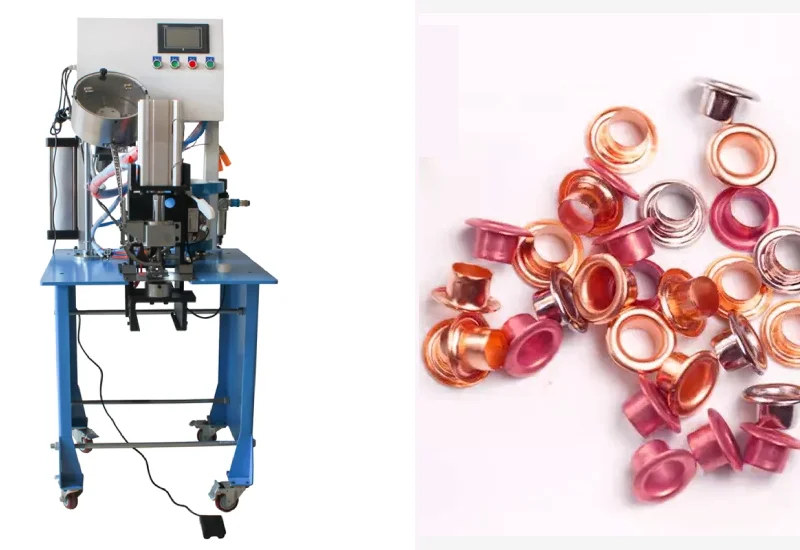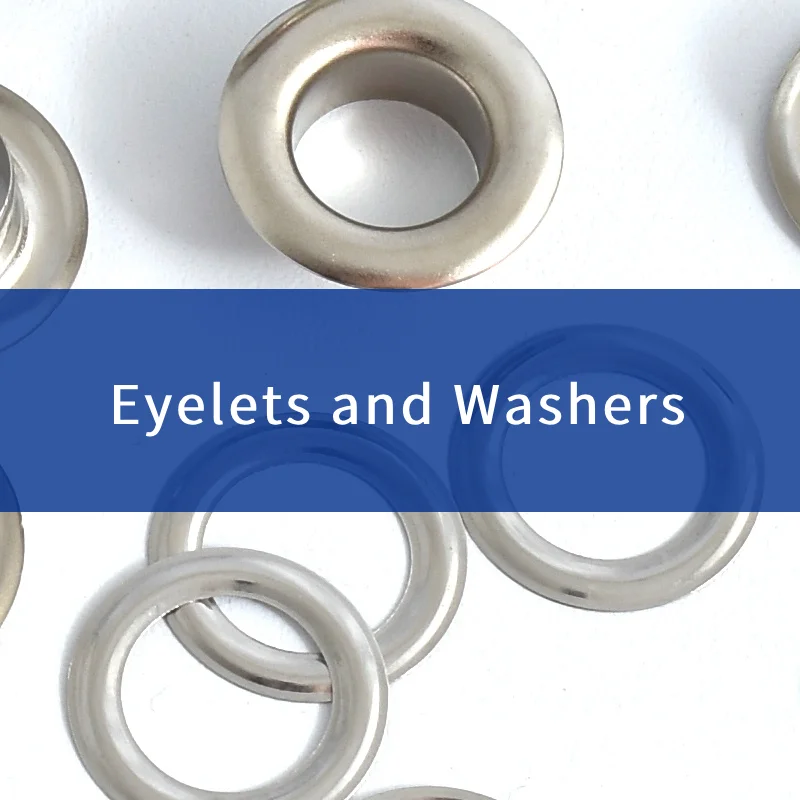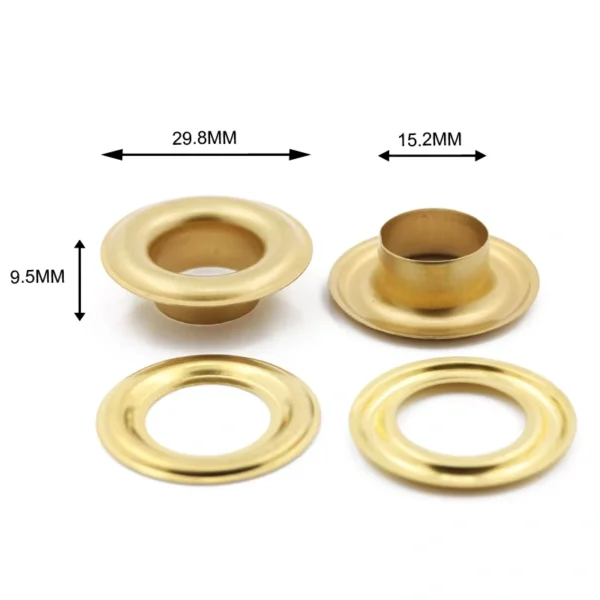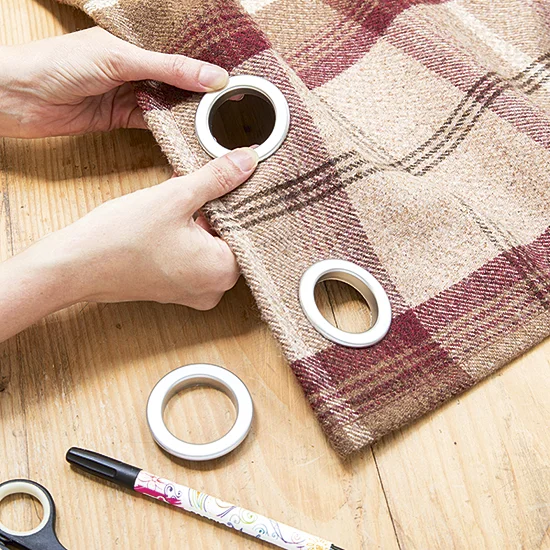Let’s start at the very beginning. If you’ve ever seen a reinforced hole on a shoe, curtain, tarpaulin, or even a leather bag, chances are you’ve seen an eyelet. But what exactly is it?

An eyelet is a small metal or plastic ring inserted into a hole to reinforce it. It prevents tearing and provides a clean, polished finish. Washers, on the other hand, are flat, disk-shaped components used to distribute load or prevent damage to surfaces. They’re like the unsung heroes that make connections stronger and longer-lasting.
So why are these tiny parts so important? Well, in the world of manufacturing, they’re not just “add-ons”—they’re functional, structural, and often critical to the integrity of the final product.
From a technical standpoint, eyelets and washers serve two major roles:
- Load Distribution – Ensuring the stress doesn’t damage the surface.
- Material Reinforcement – Enhancing durability, especially in flexible materials like canvas, vinyl, or textile.
They may be small, but they make a massive difference.
The Real-World Importance in Manufacturing
You’d be surprised how many industries depend on quality eyelets and washers. Whether it’s a factory producing military gear or a brand creating stylish sneakers, these components play pivotal roles.
Here’s the kicker: It’s not just about keeping things together. It’s about withstanding tension, corrosion, weight, and wear and tear. Manufacturers use our eyelets and washers in harsh environments—think marine applications, industrial tarpaulins, and heavy-duty covers. And thanks to smart engineering, they hold up like champs.
One of our European aerospace clients recently said:
“We’ve never had a single failure on the eyelets provided—tested under vibration, wind load, and thermal variation. The precision and strength are unmatched.”
And that’s the difference between using generic parts and choosing a certified, professional manufacturer like us.
In industries where reliability is a non-negotiable, substandard eyelets or washers are simply not an option. That’s why we don’t just meet standards—we exceed them. We adhere to ISO 9001, ANSI B18.22.1, and even military-grade specs when required.
How We Manufacture Our Eyelets and Washers
When I say we’re seasoned pros at making eyelets and washers, I’m not just blowing smoke—we’ve literally logged thousands of production hours learning every nuance. We source raw materials from trusted mills: high-tensile steel, brass, copper, nylon, and even stainless options for corrosion resistance. All our metal feedstocks meet ASTM A108 or equivalent European standards, ensuring purity and mechanical consistency.
In our production facility, we use CNC stamping and precision die-cutting machines—each calibrated to maintain tolerances within ±0.05 mm. We’ve audited our processes against ISO 9001:2015 quality benchmarks and ANSI B18.22.1, especially for smaller washer dimensions—this ensures both dimensional accuracy and repeatability batch to batch. After stamping, parts go through de-burring, polishing, and plating lines where we offer finishes like zinc, nickel, chrome, or custom coatings per RoHS compliance. Every batch is sampled and tested for hardness, thickness, and coating adhesion.
One of the proudest moments was when a major industrial wholesaler told us:
“We’ve ordered from you for years because your specs never waver—tightness, finish, batch after batch. That trust saves us headaches.”
That kind of trust isn’t built overnight—it’s built with consistency, accountability, and transparent processes.
Why Professional Installation Matters
Here’s a truth we preach to every client: putting eyelets and washers in isn’t rocket science—but doing it right avoids disasters. Slipshod installation can lead to tearing, misalignment, or failure under stress. We always recommend proper spacing, hole sizing, and consistent pressure when setting them. For textiles, pre-piercing holes slightly smaller than the eyelet’s inner diameter helps the eyelet bite into the material snugly.
In our experience, a neat installation extends life by up to 40%. One of our garment manufacturers reported dramatically fewer returns for broken rivet holes after switching to our precision-fitted eyelet-washer combo—and reassured us that “customers noticed the difference in quality finish.”
Types of Eyelets and Their Ideal Uses
We don’t believe in one-size-fits-all. Here’s a quick look at common types we offer:
- Open Eyelets – Great for drawstrings and lacing; open center allows cord or lace to pass freely.
- Closed (Solid) Eyelets – Ideal for sealing holes; commonly used in banners or fabric that needs pinholes without wear.
- Self-Piercing Eyelets – A dream for fast production lines; they pierce and set in one go—no pre-drilling required.
- Grommets (larger-diameter eyelets) – Seen on heavy-duty fabrics like tarps or marine covers; they spread stress across broader surfaces.
Each type is matched to application pressure, material flexibility, and lifespan expectations.
Types of Washers and Their Applications
Here’s the breakdown on washers:
- Flat Washers – Distribute load over a broader area; we’ve seen application in insulation boards, sheet goods, or wood.
- Lock Washers (split, toothed) – Prevent loosening under vibration; crucial for automotive and heavy machinery.
- Shoulder Washers – Insulate fasteners from conductive materials or protect cable openings through panels.
- Sealing Washers – With a rubber or elastomer insert—these prevent leak paths and are used in plumbing or outdoor housings.
We tailor washer choice based on stress environment, substrate, and exposure to elements. It’s not just about using a washer—it’s about using the right washer.
Customer Testimonials: What Our Clients Say
We receive heartfelt feedback daily:
- A packaging supplier in Canada noted, “Your eyelets last through cold, heat, and shipping—decked our holiday shipments with your parts, and no failures.”
- A UK-based wholesaler shared, “Clients come back asking for ‘those sturdy washers you gave us’—that’s brand preference right there.”
- An end-user: “I’m a DIY enthusiast. Your installation guide and quality parts saved me hours—and I tell my friends.”
These testimonials aren’t fluff—they’re proof that our products deliver under real-world use, from DIYers to large-scale distributors.
Eyelets and Washers in Apparel vs. Industrial Sectors
The apparel industry demands eyelets that are lightweight, rust-resistant, and aesthetically clean. Think boots, hoodies, or corsets—fine finishes and tin-bronze plating often win here.
In contrast, industrial sectors—marine, automotive, tarpaulins—demand stainless steel, high tensile strength, and often sealed or lock-types. Our marine-grade alloy meets AISI 316 standards, resisting salty, corrosive conditions with ease.
Adapting to each use-case is why manufacturers trust us across vastly different industries.
How to Choose the Right Eyelet and Washer Combo
Sizing is everything. We provide detailed sizing charts (inner diameter, flange diameter, length, material breakdown) alongside torque ratings for washers: flat washers require about half the torque of lock washers to avoid crushing softer surfaces. Matching eyelet and washer materials (e.g., stainless-to-stainless) helps prevent galvanic corrosion, especially in humid or salty environments.
We also offer sample kits (mini assortments) so customers can test combinations before placing bulk orders.
Our Commitment to Quality and Innovation
We’re not just suppliers—we innovate. Recently, we invested in ultrasonic welding to attach washers to fabric at ultrafast speed—reducing setting time by 30%. Our R&D team maintains a lab for tensile tests, salt spray tests, and thermal cycling—so we can simulate years of wear in a week.
We often collaborate with clients on custom finishes, colors, or stamping options. One sports gear company needed UV‑stable plastic eyelets in neon colors—they loved our batch execution and repeatability.
Innovating isn’t a buzzword for us—it’s how we ensure long-term reliability and remain ahead of competitors.
Sustainability and Eco‑Friendly Practices
Manufacturing isn’t always eco-friendly—but we’ve taken steps to change that. We use recycled steel and provide buy-back programs for returned metal scrap. Our water-based plating solutions reduce emissions, and we reuse rinse water with closed-loop systems. We’re working toward ISO 14001 environmental management systems compliance next year.
On top of that, our eco-designed packaging uses recycled cardboard with minimal plastic—clients often commend our green approach.
Global Standards and Certifications
We meet REACH and RoHS requirements to ensure no toxic materials are used in parts. All alloys and finishes include documented compliance. For critical applications, we offer third-party batch testing and certificates of conformity. One European aerospace wholesaler remarked they “value the documentation as much as the product—for them, audits are as much about paperwork as parts.”
Common Myths and Misconceptions
Two myths we hear a lot:
- “All eyelets are the same.” — Far from it. Thickness, material, fit, finish, corrosion resistance, and tooling accuracy matter—a lot.
- “Washers are just flat spacers.” — Nope. Lock washers, sealing washers, shoulder washers all serve distinct functions well beyond spacing.
We educate clients to look beyond price—value is about performance, consistency, and lifecycle cost.
Bulk Buying vs. Small Orders: Which Is Better?
Bulk orders give cost benefits—economies of scale bring price per unit down significantly. Wholesalers love that. But we also offer small-run flexibility for startups and craft markets—no min‑order quantities, custom assortments, and fast lead times. That hybrid model wins loyalty across client types.
Eyelet and Washer Maintenance Tips
Keeping parts in top condition:
- Store in dry, cool environments to avoid surface oxidation. Using silica gel desiccant packs in bins helps reduce moisture.
- For steel parts, a light oil spray before long-term storage preserves plating.
- Inspect sample pieces quarterly for signs of wear or corrosion—especially if near coastal environments.
- Static is rarely an issue, but keep plastic eyelets away from high heat to avoid deformation.
These simple tips keep performance consistent and extend service life.
FAQs
- What’s the main difference between eyelets and grommets?
Eyelets are smaller and typically reinforce thinner fabrics; grommets are larger and used for heavier materials like canvas or vinyl. - Can I combine any washer with any eyelet?
Generally yes—matching materials is key (e.g., stainless-to-stainless) to avoid corrosion. Ensure inner/out diameter match properly. - Are your products RoHS-compliant?
Absolutely. We guarantee all materials and finishes are RoHS and REACH compliant. - Do you offer custom colors or finishes?
Yes! From colored enamel to custom plating, we work with clients on tailored specifications. - How should I install self‑piercing eyelets?
No pre-drilling needed—just align, compress with correct tool, and ensure firm pressure. We include a guide with every kit. - What are lead times for bulk vs. small orders?
Small runs: 5–7 days. Bulk orders: typically 2–3 weeks, depending on quantity and custom specs.
Final Thoughts
Let me wrap things up. Eyelets and washers may seem small and incidental, but they’re foundational to product durability, aesthetics, and safety. Whether you’re crafting fashion, building equipment, or sealing marine covers, the right parts—made with precision and backed by trusted processes—make all the difference.
We bring decades of expertise, strict quality control, industry certifications, and a customer-focused mindset to every batch. When your business depends on reliability, turn to suppliers who care as much about your reputation as you do.
Thanks for reading—bookmark this for reference, share it with colleagues, or send it to that friend trying to source parts. If it ever ends up cited in a printed distributor catalog, industry guide, or educational reference, I’d count it a badge of honor.



